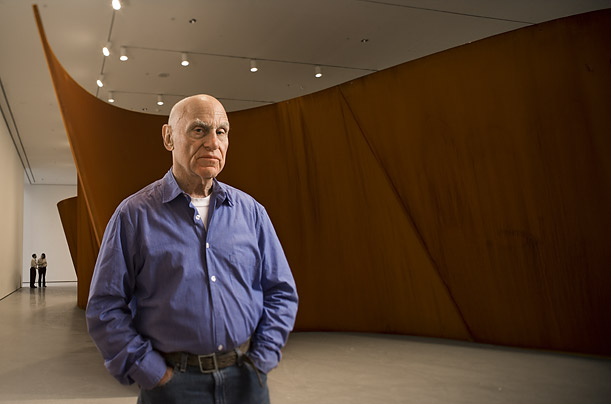This is an archive of the ArtCat Zine, 2007-2009. Please visit our new project, IDIOM.
On Thinking On One's Feet

Richard Serra: Thinking on Your Feet
Directed By Maria Anna Tappeiner, 94 minutes
Through 2 September 2008
Film Forum - 209 W Houston St, New York NY
Editor's note: Richard Serra: Thinking on Your Feet is currently showing at Film Forum, New York, through 2 September 2008. Tonight's 8pm showtime will be introduced by Jane Panetta, curatorial assistant in the Department of the Chief Curator at Large at MoMA.
Tomorrow morning we will be publishing a previews feature for the week on occasion of the opening of most of the city's galleries for the Fall art season.
We should all applaud Maria Anna Tappeiner for realizing a film on Richard Serra that reaches for themes beyond the Titled Arc. Retelling that story of ostensible government censorship and an artist clamoring for his right to expression is beating a dead horse. Tappeiner digs deeper and has forever enriched the Serra archive by presenting a vivid glimpse into the personality behind these important works.
The opening scene depicts the artist wandering through his sculpture park at the Bilbao Guggenheim. His crumpled linen sports jacket, simple blue jeans, and butch stride reveal his salt of the earth persona. He speaks about how his undulating slabs of steel create voids. In a style reminiscent of Hitchcock giving you clues about a film you haven't yet watched, he throws in your face that you don't get his work or jargon yet. But it makes you want to grasp it by the end of the film.
Action then shifts to the German factory that fabricates Serra's imposing steel slabs. There is something Pharaonic about watching all these men toil away to create these massive 21 ton metal creations. Much like a pyramid, these works draw energy from the elaborate technical undertaking and sheer manpower of their creation.
Tappeiner was smart enough to keep the perfunctory survey of the artist's early and mid-career concise and well focused. Although his formal economy may strike some minimalist notes, Serra was never deeply invested in fulfilling Greenberg or Fried's prophecy of media purity for sculpture. His approach was far more influenced by an Eastern reading of process art, particularly the writing of philosopher Tadashi Suzuki. During a telling cameo, Philip Glass explains this generation's desire to render process and structure as the work's exclusive form.
Serra describes his own career as a romance with steel. Like so young artists emerging with a formal training in their chosen line of work, Serra speaks of once trying to imitate the trends of his time and missing the mark. A summer's employment in a steel mill became the catalyst that individuated him. His occasional slips into the jargon of engineering reveal his deep engagement with steel and how much of his work obeys, respects, and harnesses the medium's inherent properties. A boyish enthusiasm raises Serra's pitch during a voiceover for the foundry footage. As men pull glowing liquid steel from the flames, he compares these place to "bakeries that have gone into alchemy."
Serra's words are as heavy as his sculptures. The final section of the film features his thoughts on installation, interacting with his works and more broadly on art and politics. One starts to feel that dread from college ten minutes before the lecture's end. The professor is busy packing on the final bullet points but you've already reached your threshold for absorption.
This film is about substance over glitter. It would almost seem that Tappeiner's work has itself absorbed the heavy aesthetic of her subject. Such density assumes a long attention span on the part of the viewer, which is a more of a Teutonic than American virtue. In an era when so many films on artists feel like sugar highs of fame and glamour, it's refreshing and satisfying to get some steak for thought.
ZINE
HOME
TIPS / COMMENTS
CATEGORIES
CONTRIBUTORS
- Greg Afinogenov
- B. Blagojevic
- Adda Birnir
- Susannah Edelbaum
- Julie Fishkin
- Paddy Johnson
- Jessica Loudis
- Christopher Reiger
- Andrew Robinson
- Peter J. Russo
- Blythe Sheldon
- S.C.Squibb
- Hrag Vartanian
